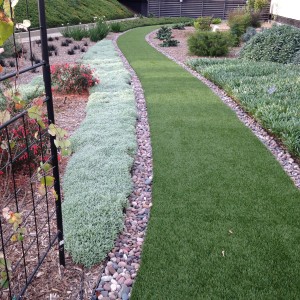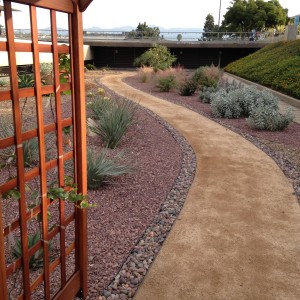 Dave Pettijohn is a tall drink of water.
Dave Pettijohn is a tall drink of water.
At a lanky 6’3,” the director of water resources for the Los Angeles Department of Water of Power (LADWP) cuts a striking figure, a handsome, calm presence in the water wars besieging our increasingly golden state.
Dr. Kelly Sanders is a rising star in the state’s water conversations, a SoCal newbie with the poise of an East Coast debutante and the gutsy candor of a veteran plainspeaker. Sanders is an Assistant Professor in the Sonny Astani Department of Civil and Environmental engineering.
I tracked both of them down after last week’s Milken Institute and KPCC-sponsored forum on the “Future of Water” and specifically the California drought and technology. So many questions remained. I was thirsty for additional knowledge and clarification and both shared their expertise with Fox & Hounds.
WE AIN’T NEW TO THIS
Pettijohn said in a phone interview there are things that Angelenos should feel good about. For one, we ain’t new to this.
“We don’t use more water than we did 40 years ago despite a million more people,” said Pettijohn. “The city’s gallons per capita per day is 109, that’s per person in the city of L.A. and that’s actually one of the lowest for any major city.”
In an attempt to make everyone’s life easier, Pettijohn helped me extrapolate some L.A. survival facts:
* odd number addresses can water mon., wed., fri., eight minute intervals up to 24 minutes a week
* even number homes can water tues., thur., sun.
* avoid watering during 9 am to 4 pm
He says the city is still flush with rebate money for those who want to replace lawns with California friendly landscapes at $1.75 per square foot. Commercial customers can get a buck a square foot up to 10,000 square feet; and .50 cents for each square foot thereafter.
 Pettijohn said the LADWP just completed two sample gardens for customers to view at its headquarters, a Southwestern and a Mediterranean style garden, both utilizing native California plants. Customers with smart phones can zap the display plants and get the info they need to plant them in their own gardens, he said.
Pettijohn said the LADWP just completed two sample gardens for customers to view at its headquarters, a Southwestern and a Mediterranean style garden, both utilizing native California plants. Customers with smart phones can zap the display plants and get the info they need to plant them in their own gardens, he said.
GRAY IS THE NEW CHIC
Pettijohn also cleared up gray areas with “graywater.”
“What is currently allowed in the city of LA is ‘laundry to landscape,’” he said. “But diverting graywater from laundry or bath out onto your property has to be done through piping underground.”
Although homeowners don’t need a permit for laundry to landscape, Pettijohn said it’s important to research which plants thrive with graywater (most, in fact) and which don’t.
Pettijohn said the LADWP’s “Technical Assistance Program” offers a quarter million dollars for industrial or commercial structures that can demonstrate graywater savings.
In addition, he said LADWP just completed a master plan for storm water (ladwp/sc) which includes large centralized projects; neighborhood scale projects and residential distributed storm water capture with rain barrels and rain gardens, where water is diverted to a slightly sunken garden area.
But he says, if the drought continues, everyone can expect more restrictions on water useage.
FORGET THE “D” WORD
“One of the things that bothers me a little bit about how people approach this drought and water management in this drought is we refer to it as ‘The Drought,’ as if it will end in a reasonable amount of time and we don’t know that,” said Dr. Kelly Sanders, also in a phone interview. “We don’t know what normal is. There are some people who think this was ‘the normal,’ and we were living in a 100 years of wet.
“Even if it starts raining, our water supply is really dependent on how much snow we have. It matters if it snows in the Rocky Mountains and if it snows in the Sierras.”
CRAZY FROM THE HEAT
She says the really concerning thing is the temperature increase.
“2014 was the hottest year we have ever seen,” she said. “And 2015 is on track to be hotter than 2014. That isn’t necessarily relating to the drought. Droughts and floods are cyclical. The fact that it’s been so hot has created a lot more evaporative losses and results in less snow pack and made us more vulnerable to wildfires.
“So we can’t say that climate change has caused this drought in full, but the hotter temperatures have made this drought more severe and more difficult to manage.
“Everyone wants the ‘silver bullet’ technology, but the solutions are largely policy and behavioral in nature.”
If she could wave a magic wand over the land she says she’d start by recycling more water.
“We need to utilize all the water sources we already have,” she said. “Our water gets returned to a sewer, to a waste water treatment facility and we have it almost clean, and we discharge it to the ocean. That’s so silly. It’s already collected, it’s almost clean… and so we have to figure out a way to utilize that resource.”
Pettijohn said many municipal facilities such as golf courses do use a “purple pipe” system, which offers treated water for irrigation and non-potable uses.
Sanders concedes that we’re doing it, just not enough.
“We do a little bit, but we’re still discharging a lot of that water to the ocean,” she said. “I think any close-to-fresh water that we discharge to the ocean is a waste.”
She said we’ve got to face the fact that drought conditions are likely the new normal in California and that means planning for a non-rainy day.
“What’s the worst thing that happens in two years? We get all the rain we wished for, but it never hurts to conserve more water or become more efficient,” she said.
Clearly, she’s not from around these parts but boy are we glad to welcome her to California.
We may not be the land of efficiency, but we have a lot of heart. And even some optimism.
As the Blasters sing in “Dry River,” some day it’s gonna rain.
Heidi Siegmund Cuda is a veteran economic and political reporter in Los Angeles who authored seminal rap and punk books and wrote a nightlife column in the Los Angeles Times. Her latest book, “Definition of Down,” written with Darlene Ortiz, is a love letter to the hip-hop generation.

